Big news from Mercedes-Benz! Not only front wheel drive and MacPherson struts, but also a host of other departures that prove the superiority of the company’s forward-thinking engineering
Let’s just hit this head-on: In spite of what some snide automotive journalists have said comparing the American introduction of a Mercedes-Benz FWD platform to “the fall of Western Civilization,†or “the end of life as we know it,†it is anything but. Instead, it represents an important, positive departure that will allow the Stuttgart company to weather the predicted turmoil of extreme fuel economy and emissions regulations, and, with it’s high-value pricing, attract another whole level of buyers to the brand, which can’t do anything but help Mercedes-Benz service specialists like you.
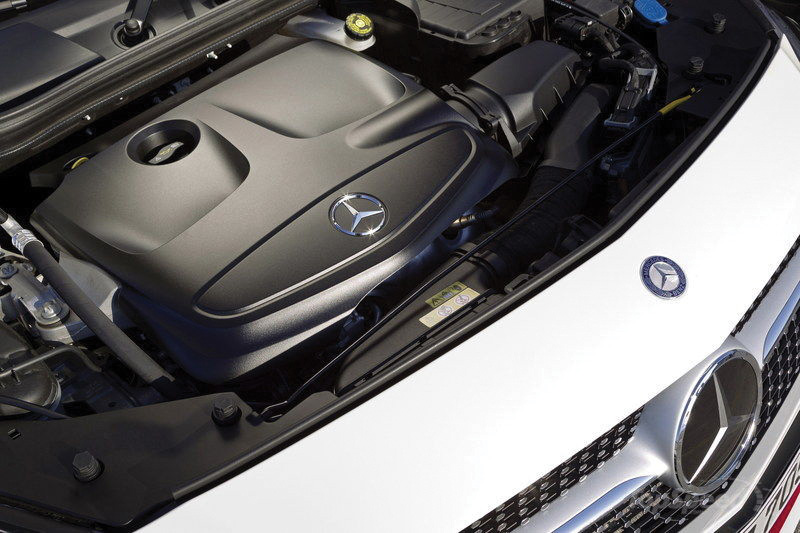
Don’t be shocked to see that four-cylinder engine in there transversely. It’s an essential element of Mercedes-Benz’s “New Generation Compact Cars†family. Shown is an A-Class, which has been successful in other markets.
The FWD CLA belongs to the company’s “New Generation Compact Cars†family, which will go a long way in defining its future, here and elsewhere. The Model Series 117 is a four-door premium coupe in the compact segment, built on the current A-Class and B-Class models sold elsewhere. Innovations abound in this class that improve energy efficiency and further reduces emissions, besides offering unprecedented safety and comfort in a car at this price point.
While you probably won’t be seeing these cars in your bays for some years, we at StarTuned believe you should have a clear idea of what your future holds, so here we’re going to lay out the amazing array of features the CLA presents (well, many of the important ones, at least).
Four – who needs more?
The AMG CLA 45 version, at $17,550 more than the CLA 250, is billed as having the most powerful production four-cylinder in the world with 355 hp and 332 ft. lbs of twist. But you’ll be seeing a lot more of the CLA 250, which is no slouch. With 208 hp and 258 ft. lbs. of torque, it produces a nice combination of 0-60 in less than seven seconds, along with 26 city/38 highway mpg — incredible for a 2L in a 3,300 lb. car.
This feat is achieved by means of the following engine characteristics (among other things):
- Low internal friction
- Gasoline direct injection
- Piezo injectors for multiple fuel injection events
- Twin-pipe/scroll turbocharging with up to 27 psi (1.8 bar) of boost
- Highly-evolved intake and exhaust camshaft dynamic timing adjustment
- Demand-controlled multi-spark ignition
- Optimized thermal management
- ECO start/stop function
- Optimized regulation of the oil and cooling circuit pumps
Drag & multi-squirt & spark
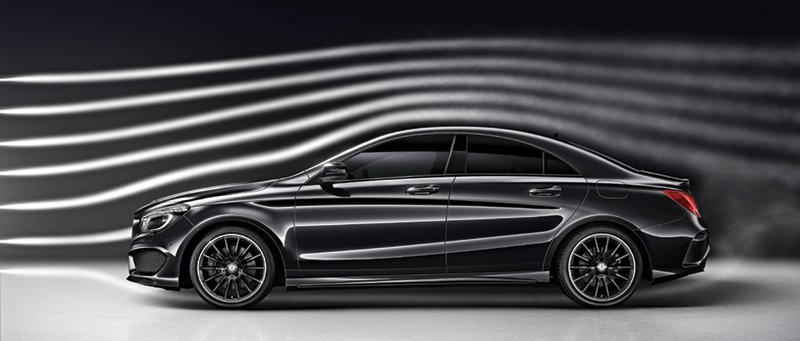
The European BlueEfficiency Edition of the CLA boasts the best aerodynamic number of any production car ever: 0.22! Special attention was paid to such details as the mirrors and windows, and the whole undercarriage has been streamlined, right down to the mufflers.
Mercedes-Benz was the first automaker to use cast-in silicon-aluminum cylinder sleeves with a low-friction surface that allows piston-ring spring tension to be reduced by 50 percent. In the CLA’s case, the cylinder sleeves get a “NANOSLIDE†coating to optimize both the production process and friction characteristics.
Other mechanical engine features include forged pistons designed to withstand ignition pressure loads of 2,100 psi (140 bar), a forged crankshaft with eight counterweights, bearing caps made of cast iron with nodular graphite, and a viscous vibration damper.
Another first for the company was the original gasoline direct injection system on the legendary 1954 300SL Gullwing. The third generation of modern GDI uses piezo-ceramic crystalline elements in the injectors. Replacing mechanical solenoids, the piezo crystal changes shape instantly when electrical current is applied, which makes it possible to program several small injection events per cycle. The first occurs as the piston is descending on the intake stroke. Depending on speed, load, and temperature conditions, another injection (or two) takes place during the compression stroke before ignition, forming a stratified mixture. A fourth injection can stabilize combustion if it’s needed. System pressure, by the way, is up to 2,840 psi (190 bar), in the range of a pre-common rail diesel.

Here’s the mighty AMG version of the CLA 2L engine. At 355 hp and 332 ft. lbs. of torque, it’s the most powerful production four-cylinder in the world.
Coordinated with that sophisticated metering of gasoline is multi-spark ignition. After the first spark, the system can recharge and deliver up to three more sparks within a single millisecond, creating a gas plasma with more expansion than conventional ignition would allow. The time lapse between sparks is adjustable, so combustion duration can actually be controlled, resulting in two percent better fuel economy, and a total of four percent improvement in combination with direct fuel injection.
Of course, these precise functions are orchestrated by the ME-SFI control unit, which is attached to the air filter housing for cooling. It does a lot more than that, though, including management of:
-
Cylinder-selective, adaptive knock control
- Electronic accelerator
- ECO start/stop function
- Stepless adjustment of intake and exhaust camshaft timing
- Turbo boost pressure
- Torque interface to ESP, transmission, and air conditioning
- Alternator interface
- Thermal management for shortening warm-up phase
- Engine oil pump control
- Exhaust flap control
- Diagnosis and fault storage
- Drive authorization system and immobilizer
If the ME detects a mechanical fault in the electronic accelerator throttle actuator, the fuel injectors are partially shut off in order to restrict engine speed to 1400 rpm at idle, and 1800 rpm while driving. Another safety-related job is shutting down the fuel pump in the absence of an engine speed signal, or if a crash signal is received indirectly via the chassis CAN, or directly from the supplemental restraint system control unit. In addition, the injectors are briefly actuated to depressurize the fuel system.
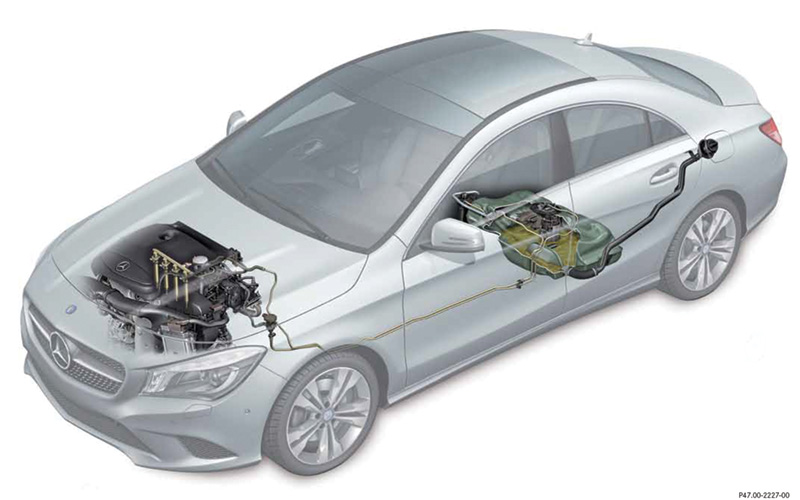
A low-pressure pump moves gasoline from the 50L high-density polyethylene tank (six layers with a block layer made of ethylene vinyl alcohol to prevent hydrocarbon evaporation) to the high-pressure pump, which can generate an impressive 2,840 psi (190 bar).
Current management
The electrical system battery (G1) is located in the driver’s side of the engine compartment. An additional battery (G1/13) for the ECO start/stop function is installed in the front passenger footwell.

The 7G-DCT transaxle is a seven-speed, dual-clutch, three-shaft unit. Clutching and gear changes are rapid with no rpm flare.
The energy management system ensures that the engine can be started and that all electrical consumers receive a reliable power supply. This is achieved through the major assembly coordinator and on-board electrical system management subsystems. The major assembly coordinator is integrated into the ME and forms the interface of the on-board electrical system management to the alternator. The ME communicates with the alternator via the powertrain LIN (LIN C1). The major assembly coordinator regulates the power output of the alternator in accordance with the instructions of the on-board electrical system management, taking engine load into account.
The on-board electrical system diagnosis function provides precise analysis of causes in the event of complaints. The last 100 driving and idle cycles are stored with important information. This can be read out using Xentry. In addition, the diagnosis function now makes it possible to read the no-load current curve for the most recent hours and display it graphically.
Trans
Â
| Â At a Glance… |
CLA250 |
CLA250 4MATIC |
|
MSRP |
$29,900 |
$31,900 |
|
Fuel Economy |
City: 26MPG Highway: 38MPG Combined: 30MPG |
TBA |
|
Engine |
2.0L Inline 4-Cylinder Turbocharged |
2.0L Inline 4-Cylinder Turbocharged |
|
Performance |
208 HP 258 lb-ft torqu |
208 HP 258 lb-ft torque |
|
0-60 (sec.) |
 6.9 |
6.8 (est.) |
The adoption of FWD and the tightened requirements for performance and fuel efficiency resulted in a truly unique new transaxle. The 7G-DCT is a 7-speed dual-clutch, three-shaft transmission unit. It consists of two sub-transmissions each with its own clutch. Clutch operation and gear changes occur rapidly without interruption of tractive power for improved efficiency and sporty vehicle dynamics.
A few more important features of the 7G-DCT:
- Wet, hydraulically-operated dual clutches
- One oil circuit for hydraulic control and lubrication of the gear set
- Integrated electric auxiliary oil pump
- Integrated shift-by-wire
Cooling is handled by an active oil system. It is also suitable for usage with the start/stop function. When this function is active (engine off), the electric auxiliary oil pump supplies the shift elements and actuators with oil.
Automatically controlled all-wheel drive (4MATIC) is optional, with power sent to a multi-disk clutch in the rear axle differential.
Electrically-powered steering
Yet another big advance is the electric power steering, which consists of a rack-and-pinion steering gear, a torque sensor, an actuator motor, and a control unit. The steering assistance is transmitted by the motor to the rack-and-pinion to boost the steering moment applied by the driver. Compared to hydraulic power steering, electric steering force assistance offers the following advantages:
- Improved steering feel
- Fuel savings
- No power steering fluid required
- Compact design
- Speed-dependent steering force assistance
- Assisted steering return
- Diagnosis capability

4MATIC is a great option. The rear axle carries a multidisc clutch, and up to 50% of the engine’s torque can be directed to the rear axle.
The brake and engine intervention functions of ESP, which are intended to stabilize the vehicle, have been supplemented by steering torque intervention. This additional steering torque is provided in the form of electric steering force assistance.
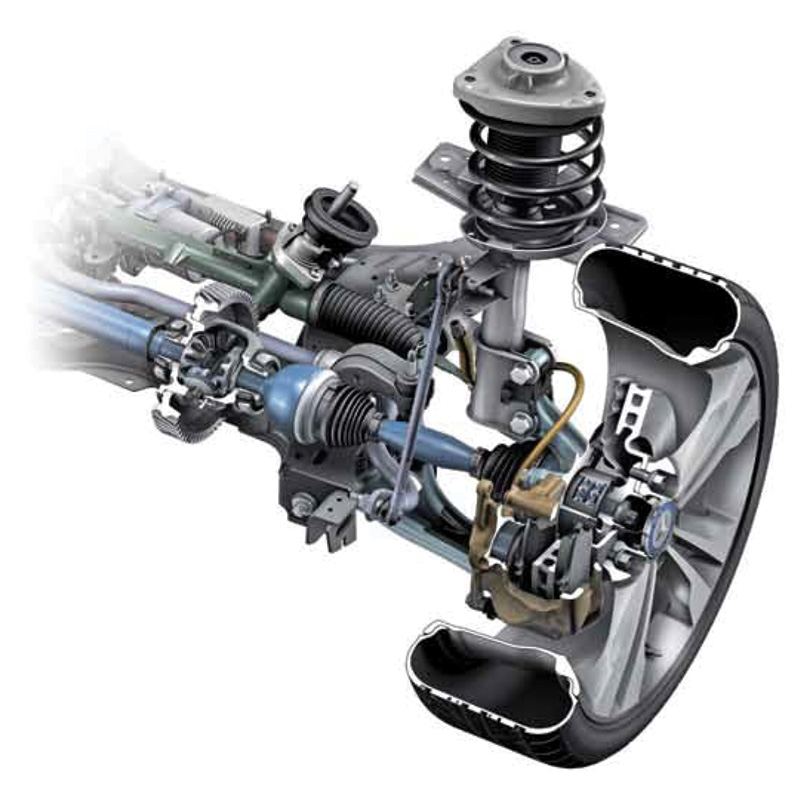
This may look like terra incognita to you — FWD, MacPherson struts, and electrically-powered steering — but it’s thoroughly modern and works superbly. Note the long link between the stabilizer bar and the strut.
Tons of brake features
Mercedes-Benz has spared no effort to make sure the CLA has an integrated brake system that’s more than a match for the competition where high-technology is concerned. For example, ABR (Adaptive Brake) assists the driver in dangerous situations which occur suddenly. The familiar system has been adapted to the new model series and consists of the following subfunctions:
- Electronic Stability Program (ESP)
- Electronic brake force distribution (EBD)
- Anti-lock braking system (ABS)
- Acceleration skid control (ASR), electronic traction system (ETS)
- Brake Assist (BAS)
- Dry braking
- Precharging, depending on accelerator
pedal actuation - Precharging, depending on lateral acceleration
- Standstill coordinator (SSK)
- System fault display
- ESP dynamic cornering assistant
There’s even an electric parking brake, which is identical to that found on models R231 (SL) and R172 (SLK). It acts on the rear wheels by making use of special electrically-adapted brake calipers, which are operated via a switch on the instrument panel.
As you can see, there’s way too much new technology in the CLA for us to be able to delve very deeply into it in one magazine article, but we will concentrate on the operation and diagnosis of specific systems in future issues of StarTuned.


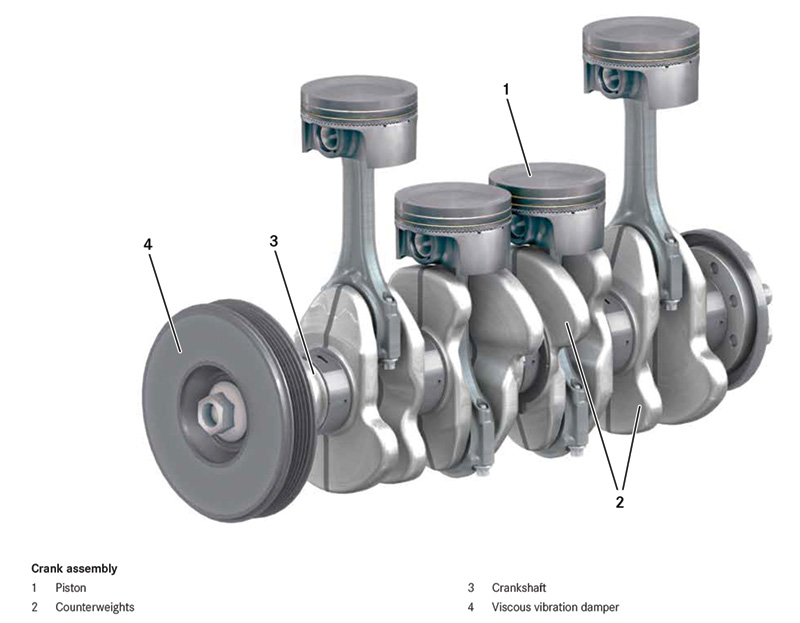




0 Comments